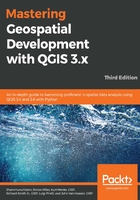
A Refreshing Look at QGIS
In this chapter, we will review the basic functionality of QGIS and explore some of the new features of versions starting from 3.4. If you need a refresher on QGIS or a quickstart guide to QGIS, you should read this chapter. The topics we will cover in this chapter are as follows:
- Downloading QGIS and its installation
- The QGIS graphical user interface
- Loading data
- Working with coordinate reference systems (CRS)
- Working with tables
- Editing data
- Styling data
- Composing a map
- Finding and installing plugins
QGIS is a volunteer-led development project licensed under the GNU General Public License, and was started by Gary Sherman in 2002. The project was incubated with the Open Source Geospatial Foundation (OSGeo) in 2007, with QGIS 1.0 being released in 2009. The continued development of QGIS is supported by an active and vibrant community from around the world. Many people assume that they can only help with the development of QGIS if they can perform computer programming, but this is false! QGIS has many community members that write documentation, test the program for bugs, translate documents, answer forum questions, and provide financial support. QGIS user groups exist as well, aiming to bring people together to share experiences of QGIS. It is easy to get involved, and the authors encourage you to consider contributing. Learn about how to get involved at http://qgis.org/en/site/getinvolved/.